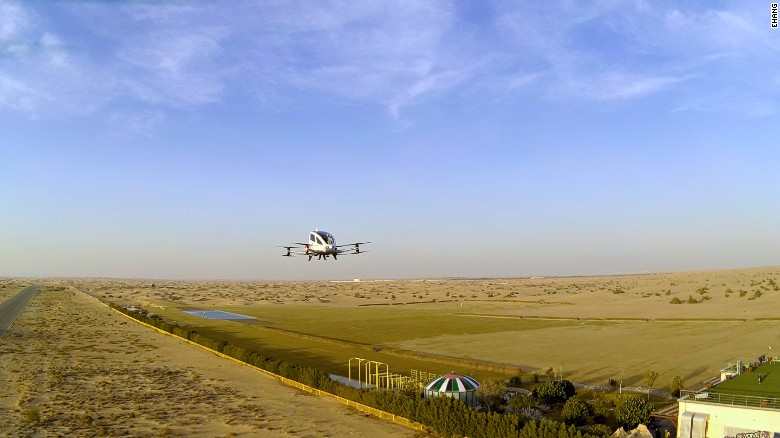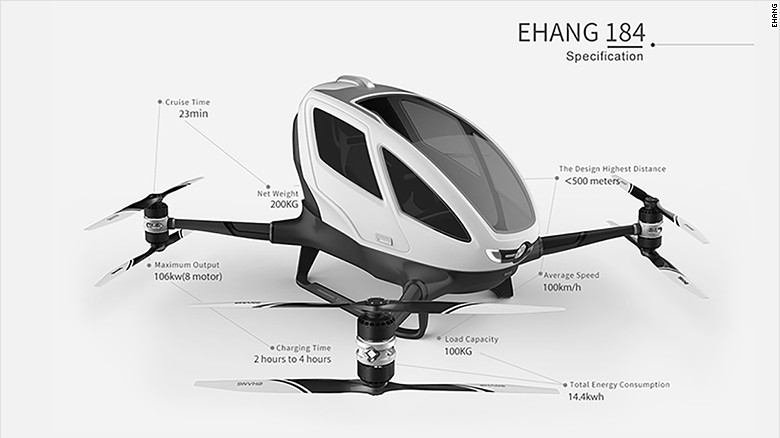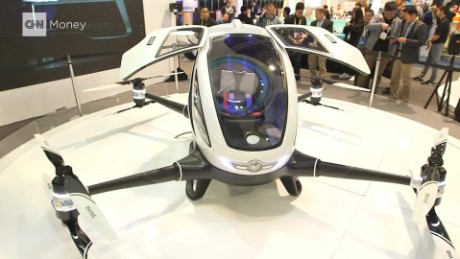As reported by CNN: Dubai has announced yet another pioneering initiative, but this time it's not the world's first rotating skyscraper or 3D printed office. It's a fleet of flying taxis.
Small enough to fit into a car parking space when folded up, the one-seater passenger drones made by Chinese company Ehang are set to start picking up passengers in July this year, according to Dubai's Road and Transport Authority (RTA).
The electrically powered driverless drones -- named Ehang 184 -- have already been seen hovering above the sand dunes near the city's airfield during test flights.
"The 184 provides a viable solution to the many challenges the transportation industry faces in a safe and energy-efficient way," said Ehang founder and CEO Huazhi Hu when the vehicle was unveiled during the 2016 CES gadget show in Las Vegas.
"The 184 is evocative of a future we've always dreamed of and is primed to alter the very fundamentals of the way we get around."
Self-driving transport strategy
While the exact details of the project's logistics are yet to be revealed, Dubai's RTA says the futuristic venture is part of a strategy to have self-driving vehicles (of all kinds) account for a quarter of journeys made in Dubai, by 2030.
"This project supports Dubai's government's direction to become the smartest city in the world," HE Mattar Al Tayer, director general of RTA, said in an email to CNN.
He adds that the drones, which he refers to as Autonomous Aerial Vehicles (AAV), are an easy-to-use innovation that can transport up to 100 kilograms -- enough for one person and a suitcase -- on a pre-programmed route through the city.
"The passenger just needs to pick the destination through a smart screen [once inside the vehicle] and the AAV takes care of the rest."
Monitored by ground control
Powered by eight propellers, Ehang says the 184 (which stands for one person, eight propellers, four arms) will cruise at around 100 kilometers per hour.
The routes will be programmed by a ground control center through an encrypted 4G network which will monitor the flight.
Awesome as it might sound to sit back and take in the view as the rest of Dubai is stuck in traffic jams, there are some limitations to the technology.
And then there are the usual concerns about drones in busy airspaces and the safety of driverless vehicles.
But like it or not, automated passenger drones will become a reality, says Captain Ross Aimer, CEO of US-based Aero Consulting Experts..
"It's the future," he told CNN. "We have the technology and it can be done. It's time."
"The passenger drone is really just one step up from the delivery drones we've seen perforating the skies in recent years,"
'What if?'
A pilot himself, Aimer is watching the venture with great interest and has identified both pros and cons with the driverless technology.
Among the caveats is the question of what happens if ground control loses the connection to the drone, he says.
"That's most people's concern with any pilotless aircraft," says Aimer. "We have the technology to send a signal to that aircraft and control it and communicate with it, but what happens if that technology is interrupted for some reason?
According to Ehang, in the event of any problems the drone will immediately land at the nearest safe spot. But that may not be enough to reassure everyone.
As Aimer puts it -- "My question is: who's gonna be the man or woman crazy enough to be the first passenger?"


 With a 30-minute maximum battery time, it won't take you very far.
With a 30-minute maximum battery time, it won't take you very far.
No comments:
Post a Comment